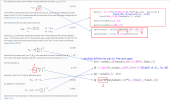Hello, everyone:
I am now using CLM version 5.0.35 to change the soil thermal conductivity. In some literatures, the change of soil thermal conductivity needs to use the mass fraction of mineral soil, the volume fraction of mineral soil and the mass fraction of organic matter. In this regard, I have some questions about the variables in CLM as follows:
Question 1:About organic matter
I found the om_frac variable in SoilStateInitTimeConstMod.F90, whose long name is organic matter fraction. Is the om_frac variable the volume fraction of organic matter or the mass fraction of organic matter? In SoilStateInitTimeConstMod.F90, om_frac = organic3d(g,1)/organic _ max, where organic 3d (g, 1) is the density of organic matter in surfdata, it seems that the om _ frac variable seems to be the mass fraction of organic matter. Is this my correct understanding?
Question 2: About mineral soil.
In SoilStateInitTimeConstMod.F90, there are:
(1._r8-om_frac) is a fraction of mineral soil, which refers to the mass fraction of mineral soil or the volume fraction of mineral soil? If om_frac is the mass fraction of organic matter, then (1._r8-om_frac) should be the mass fraction of mineral soil. In the change of soil thermal conductivity, the volume fraction of mineral soil is needed. How should this be converted? Or is there any literature to refer to?
I am now using CLM version 5.0.35 to change the soil thermal conductivity. In some literatures, the change of soil thermal conductivity needs to use the mass fraction of mineral soil, the volume fraction of mineral soil and the mass fraction of organic matter. In this regard, I have some questions about the variables in CLM as follows:
Question 1:About organic matter
I found the om_frac variable in SoilStateInitTimeConstMod.F90, whose long name is organic matter fraction. Is the om_frac variable the volume fraction of organic matter or the mass fraction of organic matter? In SoilStateInitTimeConstMod.F90, om_frac = organic3d(g,1)/organic _ max, where organic 3d (g, 1) is the density of organic matter in surfdata, it seems that the om _ frac variable seems to be the mass fraction of organic matter. Is this my correct understanding?
Question 2: About mineral soil.
In SoilStateInitTimeConstMod.F90, there are:
uncon_frac is fraction of mineral soil plus fraction of "nonpercolating" organic soil
uncon_frac=(1._r8-om_frac)+(1._r8-perc_frac)*om_frac
uncon_frac=(1._r8-om_frac)+(1._r8-perc_frac)*om_frac
(1._r8-om_frac) is a fraction of mineral soil, which refers to the mass fraction of mineral soil or the volume fraction of mineral soil? If om_frac is the mass fraction of organic matter, then (1._r8-om_frac) should be the mass fraction of mineral soil. In the change of soil thermal conductivity, the volume fraction of mineral soil is needed. How should this be converted? Or is there any literature to refer to?

